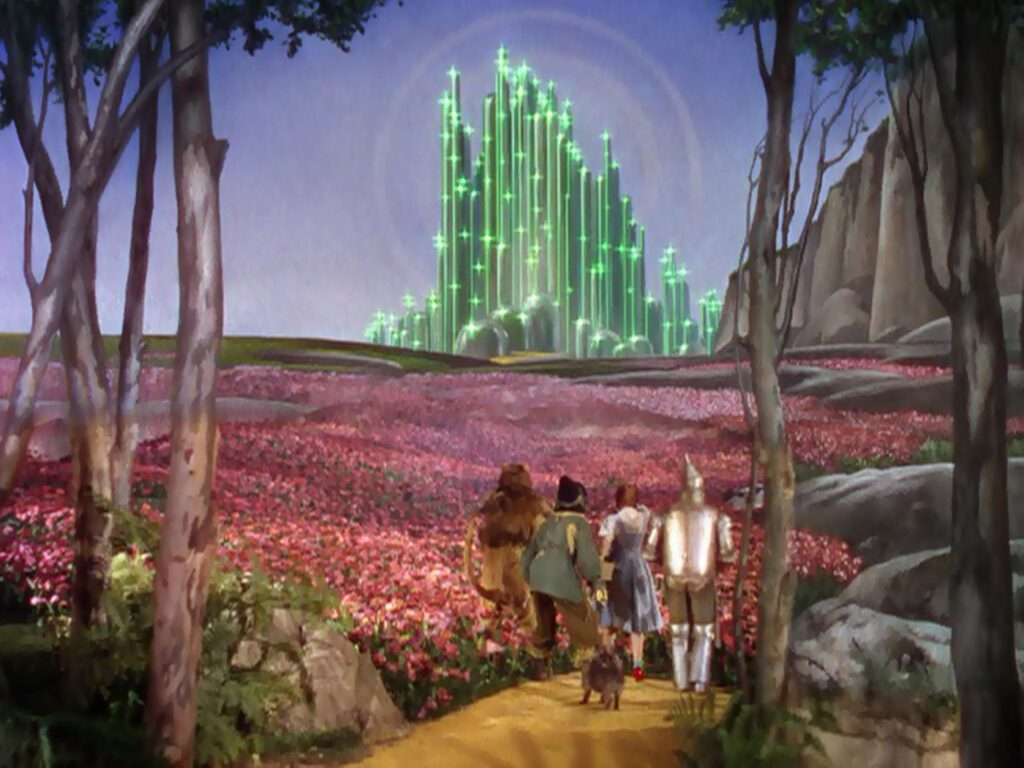
The Wizard of Oz
1939, directed by Victor Fleming et al.
If it’s impossible to identify the most frequently watched movie in history, still it’s hard to think of any contender besides The Wizard of Oz. It’s been popular worldwide for roughly five generations, and it appeals to all ages, so adults are happy to watch it with their children. People tend to see it again and again, and it’s been widely distributed in every major format: movie theater revivals, annual television broadcasts from 1959 to 1998, home video, dvd, blu-ray, and streaming. Its 38-year head start over Star Wars, for example, gives it an advantage over any modern blockbuster.
Beyond these obvious factors, and beyond the many pleasures that make The Wizard of Oz so attractive, there must be something universal in it that speaks to so many different generations, nationalities, ages, and types of people. Defining the movie’s lessons brings us partway to an answer. After living out her dream of escape and excitement, Dorothy comes to appreciate the value of her home, family, and ordinary life (“There’s no place like home.”) Along her way come a few secondary lessons – Glinda tells her she needed to learn everything first-hand through hard experience; the Wizard’s bad example teaches her not to trust magical promises; and in the witch’s castle she learns to take an active part in solving problems. Meanwhile her three companions, the Scarecrow, Tin Man, and Lion, find that the missing pieces they longed for were inside themselves all along.
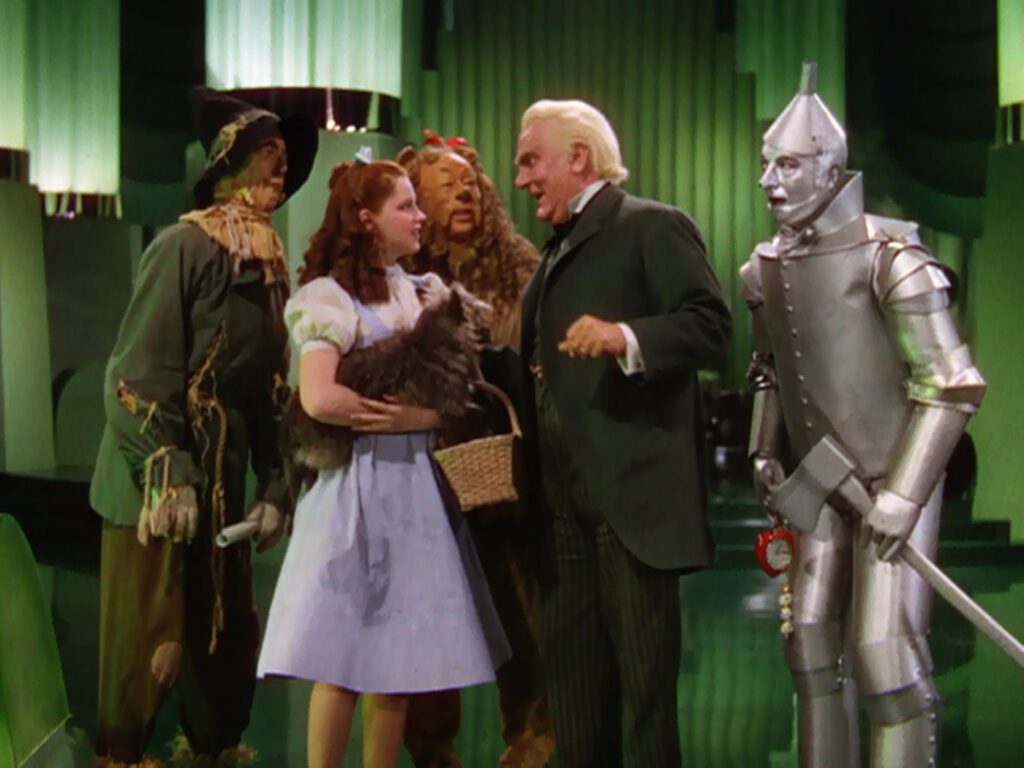
Of course a movie cannot spread itself thin by teaching its audience all the facts of life. It has to have a focus, and in fact all of these lessons come down to a single basic idea – the importance of treasuring and relying on what we already have. So many of humankind’s problems, from global history down to a personal scale, are caused by the perpetual urge to seek something better, magical, glamorous, powerful, or exciting – something “over the rainbow” that we don’t yet possess. As long as humans survive they’ll probably have a need for this movie’s wisdom.
These values may be timeless and universal, but they also summarize what society had learned through the scarcity of the Great Depression, which ended the year The Wizard of Oz was released. The tornado sweeping through Kansas farmland would have awakened recent memories of the Dust Bowl, but more to the point, the movie fits the progressive ethos of Franklin Roosevelt’s presidency. Dorothy’s family and her three traveling companions are simple and virtuous, in contrast to the wealthy Elmira Gulch (who “owns half the county”) and the powerful but fraudulent Wizard. The deaths of the wicked witches are occasions for liberation, first of the Munchkins then the witch’s minions. For a few moments the Lion fantasizes about being a king, but his song (surely the film’s least catchy music) mocks his aspirations, and in the end he finds virtue to be its own reward. When the Wizard flies off in his balloon, he divides his power among the three lowly characters who came to him.
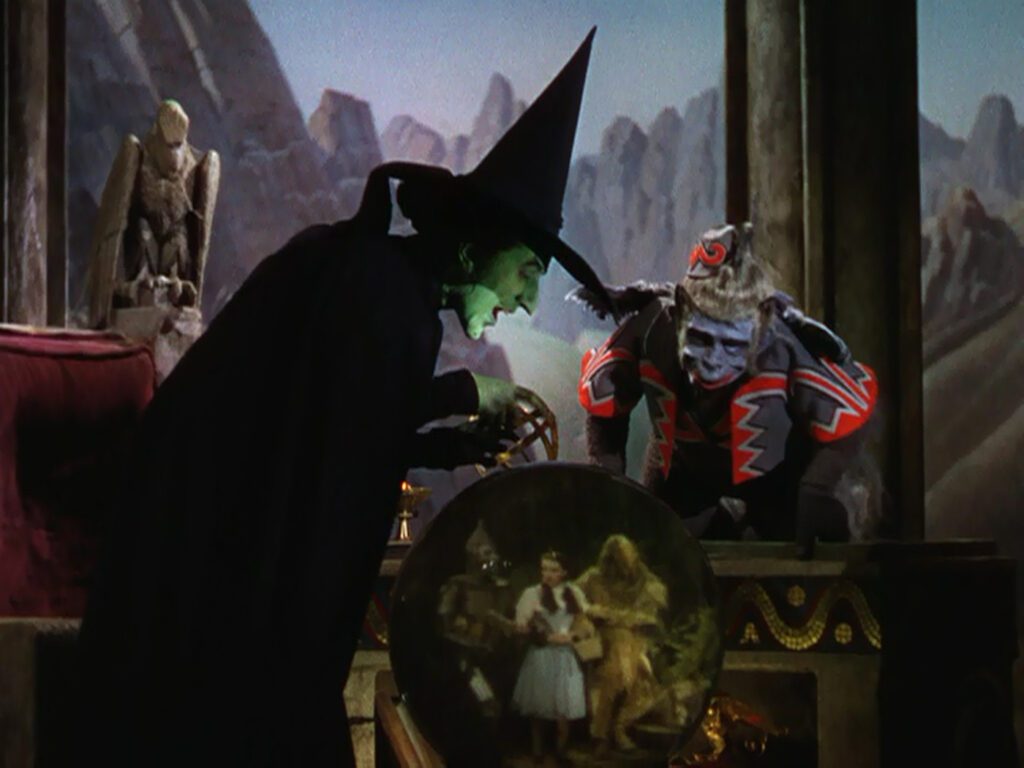
The movie is also progressive in inverting patriarchal hierarchy. Every powerful or instrumental role is played by a woman – Dorothy, Aunt Em, Elmira Gulch, and the witches, while all the male characters are weak or subservient – the Wizard, Uncle Henry, the three farmhands, the Scarecrow, Tin Man, Lion, and the witch’s minions. (This reversal of the gender hierarchy is fairly common to Hollywood musicals; those that work best generally give women the stronger roles.) But the most daring challenge to social norms is Toto, who is a veiled surrogate for what the movie could not get away with showing in 1939: an illegitimate child. Of course Elmira Gulch is just mean enough to snatch a small dog from a young girl, but the situation changes little if we view Dorothy as an unwed mother trying to protect her fatherless child from a judgmental and adverse world.
The Wizard of Oz uses a classic framing structure, much like The Cabinet of Dr. Caligari, in which a realistic setting brackets a fantastic or unreal inner story. As in Caligari, most of the fantasy characters are transformations of people the protagonist knows from the real world. The Wizard, the Wicked Witch of the West, and Dorothy’s three companions all have counterparts in Kansas. Oddly, however, Aunt Em and Uncle Henry have no counterparts in Oz, while Glinda has none in Kansas. The insinuation is that Dorothy is an orphan, in which case it would be natural for her to dream of her long-lost mother in the idealized form of Glinda, who protects and advises Dorothy but also lets her discover the ways of the world on her own.
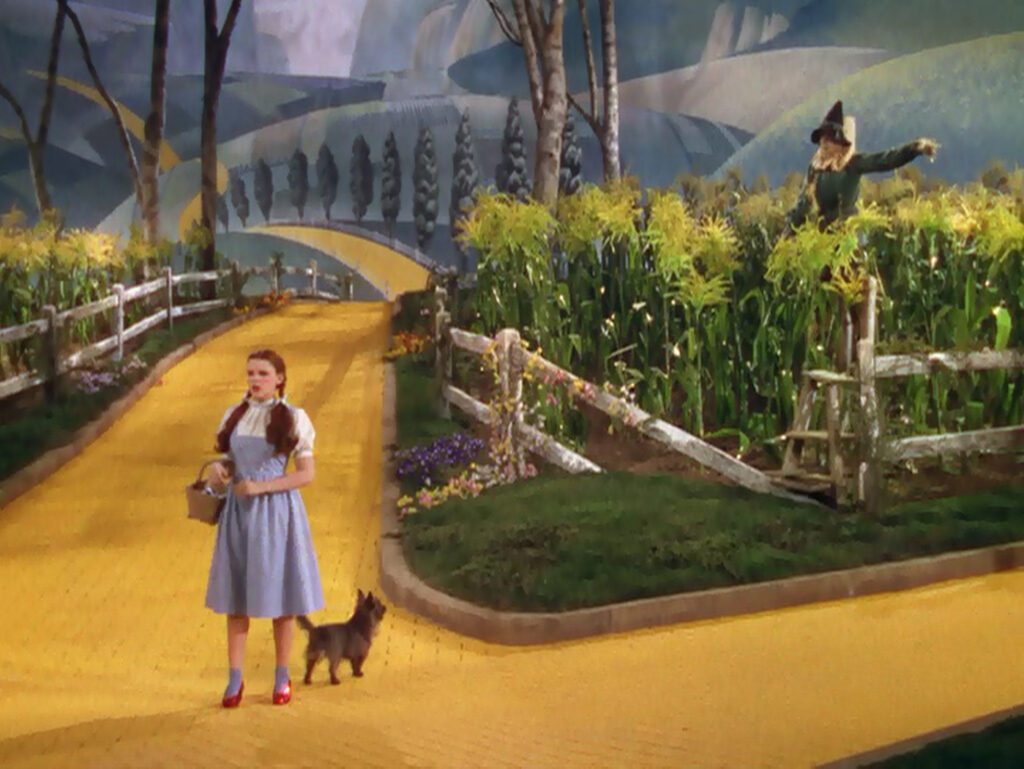
Dorothy’s journey through Oz is a process of growing up, divided into three stages:
- Munchkinland represents childhood, with small people, bright colors, and the wonder of being in a new place. Everything is round like a womb, like the Munchkin houses and the spiral of the Yellow Brick Road. Until she leaves the Munchkins, Dorothy has the maternal Glinda to guide her.
- The Yellow Brick Road represents Dorothy’s budding maturity as she’s left to her own devices. Each time she meets a new companion she must summon from within herself whatever her new friend lacks. When she picks up the Scarecrow she needs her brain to navigate the crossroads; the Tin Man appears after the talking trees upbraid her for being selfish; and the Cowardly Lion appears when she and her first two companions are afraid of the dark woods.
- The Witch’s Castle and Emerald City represent adulthood. Dorothy must confront the Wicked Witch and the Wizard, challenge authority, and protect her companions as well as Toto.
Just as Dorothy grows up in three stages, her companions represent three essential ingredients of maturity. Neither brains nor heart nor courage is sufficient to a complete human being; anyone who lacks any one of those qualities is handicapped.
All of this goes a long way toward accounting for The Wizard of Oz‘s appeal across time and around the globe. Even if the lessons and analogies remain unspoken, audiences probably intuit them on some level. These observations also give reasons for the film’s enduring influence. Although few movies have dared to retell the story directly – justifiably reluctant to compete with MGM’s consummate production – the variety of movies that echo its major characters and story elements confirms the movie’s universality. For instance, trios of characters who embody intellect, love, and courage (or lack thereof) appear in films as diverse as Cries and Whispers, Stalker, and The Counselor.
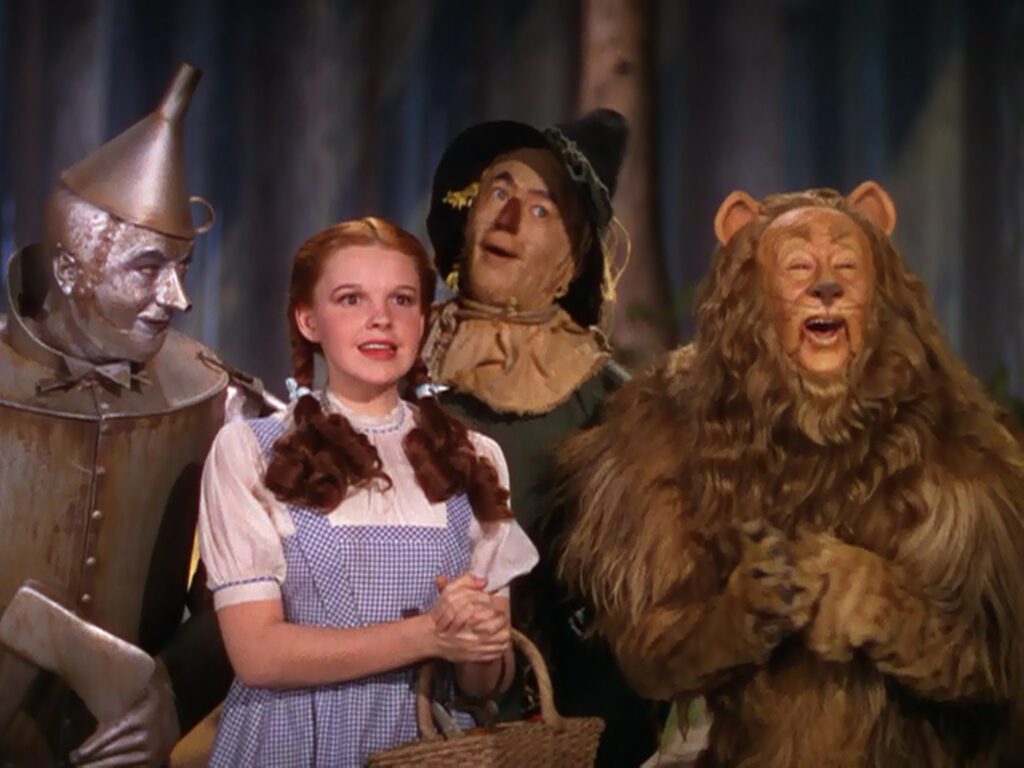
There’s still a paradox in the contrast between Oz and Kansas. While most viewers accept the ending and believe that Dorothy is happy to be home, nevertheless the delights of Oz have not dissipated. The movie’s pleasures are mainly in Dorothy’s colorful dream, and none of its lessons cancels out the enjoyment of her fantastic journey. While the movie argues against the folly of looking “over the rainbow” it still seems to glamorize her fantasy. In this paradox however The Wizard of Oz acknowledges the complexity of reality… unattainable fantasies will always have their allure, but if we can see them as transformations of the real world we can also begin to discover fantastic qualities in everyday reality.
Dorothy’s dream of a better world “over the rainbow” introduces the story’s arc, preparing for her eventual appreciation of home. It’s part of a timeless lesson, which is enough to justify it, but at the same time it’s also a metaphor for the allure of movies, which so often seduce audiences with exalted visions of life. When Dorothy and Toto step out of their house into Oz it’s almost as if they’re stepping into a movie, and the transitional scene during the tornado plants the idea. As the house flies through the air Dorothy sits on her bed facing a large window with the aspect of a movie screen, where she sees a woman in a rocking chair, two men rowing a boat, and a witch riding a broomstick. These surreal images are like the variety of genres in Hollywood movies – domestic melodrama, action, and horror.
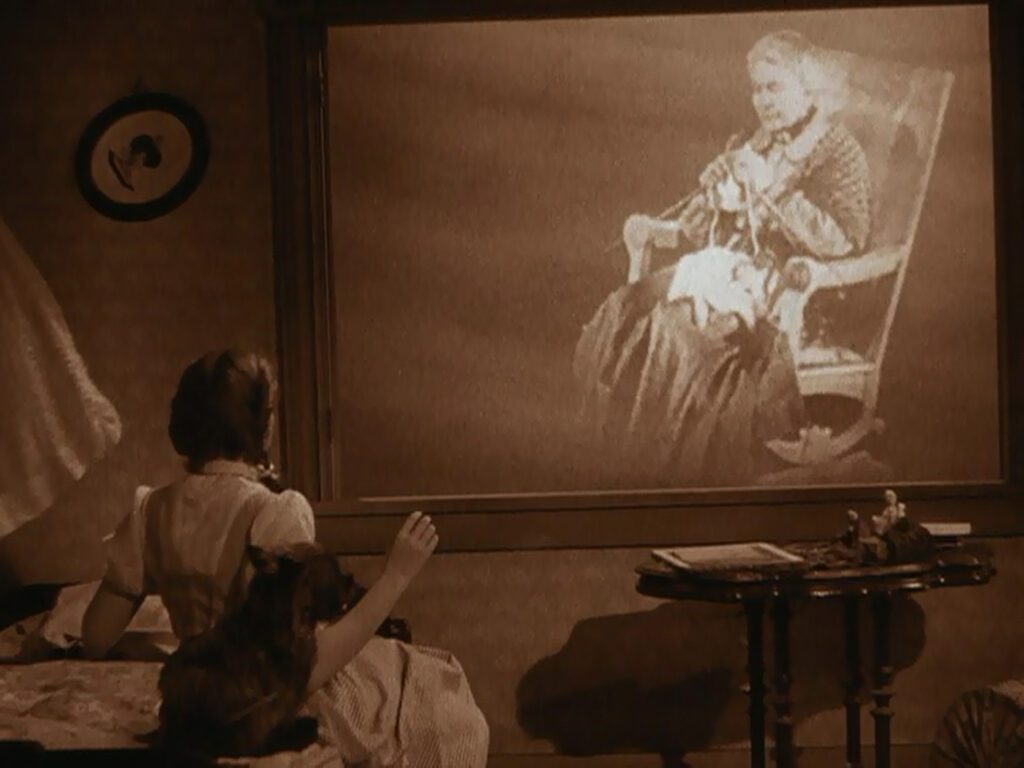
Hollywood’s “dream factory” has done much to influence modern people’s thinking, introducing appetites for glamor and heroism that were never so dominant in past centuries, and dangling fantasies of excitement and drama that challenge people’s satisfaction with their ordinary lives. At the same time, early Hollywood was often a positive social force, helping to reconcile people to the difficulties of family life, economic hardship, or social conflict. Sometimes, in movies like The Wizard of Oz, Hollywood showed self-awareness, acknowledging its negative influence and offering a corrective to it.
CONNECTIONS:
The Cabinet of Dr. Caligari – Framing story that transforms everyday reality into fantasy; key character(s) missing from framing story
Sunrise – Journey from a farm to a fantastic city; universal lesson of maturity and modesty
Red-Headed Woman – Consistent pattern of strong female characters and weak males
Midnight – Woman from the American heartland traveling in a foreign land meets three men who possess surfeits of brains, heart, & courage
The Sea Wolf – Woman with three men defined by absence of brains, heart, and nerve; transition in a doorway from recognizable life to a fantastic setting
I Wake Up Screaming – “Over the Rainbow” song linked to a wish for glamor
Holiday Inn – Combination of qualities to form a complete person; upholds traditional American values over Hollywood
The Hard Way – Young woman leaves bleak town for a glamorous city, uses name Dorothy
Laura – Physical or figurative journey through an exalted world; trio of men lacking intellect, heart, and courage; innocent young woman from a humble background
Beauty and the Beast – Parallels between a mundane home life in the countryside and a land of fantasy
Sunset Boulevard – Characterization through mind, heart, & courage (Dorothy’s companions) or “courage and wit and heart” (the young Norma Desmond); nuanced critique of Hollywood
Juliette, or the Key of Dreams – Framing story with parallels between dream and reality; attraction to illusion
Early Summer – Protagonist finds at the end what was close to her all along; “There’s no place like home” spoken or implied musically
Phone Call from a Stranger – Character flees the Great Plains for an exciting city, meets three friends with different problems, and learns there’s no place like home; travelers touch ground in the middle of their journey
Ugetsu monogatari – Character who learns to value home and character(s) who find missing piece
Ordet – Trio of men whose problems concern mind, heart, and courage or faith
The Misfits – Young woman in unfamiliar surroundings with three broken men and a dog; last word is “home”
Charade – Three men trying to help/harm a innocent young woman
Au hasard Balthazar – Mind, heart, and spirit combine to create a complete character
Seconds – Protagonist pursues a dream that’s out of reach and then returns home
Barbarella – Woman’s journey to colorful fantasy land; munchkins/biting dolls; meets or sleeps with three men; Emerald City/Sogo; Wizard/Durand Durand; Wicked Witch/Great Tyrant; Winkies/Black Guards; crystal ball/Matmos
La rupture – Reality preferable to a dream world; doubling of characters between the two worlds; story in the form of a fairy tale
Solaris – Journey to a fantastic place with homecoming at end; woman accompanied by three flawed men short on brains, heart, and courage; hot air balloons
Cries and Whispers – Woman accompanied by three characters who lack education, heart, and courage
Stalker – Three men lacking brain, heart, courage on journey to have wish granted; central fantasy framed by home filmed in sepia; Oz/Zone; lion’s crown/crown of thorns; oilcan/pom-pom hat; sleep in middle; dog follows character/s through fantasy; character pelted for tugging on a tree
Nostalghia – Home filmed in sepia, foreign land filmed in color
The Sacrifice – Color scheme reversed in the middle; mission at witch’s home; witch on a bicycle; granting of a wish; three men lacking brains, heart, and courage; tornado/war; Toto/Otto; home as a synonym for happiness
Blue Velvet – Character named Dorothy with red shoes who’s trapped in a fantasy world
Wild at Heart – Glinda as deus ex machina; translation of Dorothy into a sexual character
The Adventures of Priscilla, Queen of the Desert – Bracketing; three characters on a journey of self-discovery; Dorothy/Priscilla; final line about homecoming
L.A. Confidential – Trio of male characters who discover their brains, heart, and courage; character with a castle or mansion associated with the west; innocent woman who came to a glamorous city and returns home; powerful man who turns out to be a fraud
The Truman Show – Hollywood criticizing itself; dogs as link between fantasy and reality; inversion of “no place like home”; sky (rainbow, tornado, inner dome) as barrier or transition between worlds; disappointing reality of a fantasy’s actualization
Eyes Wide Shut – “Over the Rainbow” vs. “Under the Rainbow”; story of someone seeking excitement who comes to appreciate life at home
Italian for Beginners – Trio of characters who lack brains, heart, courage; orphans; home/togetherness
Mulholland Drive – Framing story; girl seeking an exciting life far from home; Winkies/Winkie’s diner
Matchstick Men – Ordinary life preferable to excitement and success; “There’s no place like home.”
The Counselor – Three male characters lack brains, heart, courage; diamond as crystal ball; witch/Malkina and wizard/druglordd
NOTE:
Anyone looking for interpretations of The Wizard of Oz will inevitably come across Henry Littlefield’s argument that the story is an allegory for U.S. monetary policy, with the Yellow Brick Road representing the gold standard, the name “Oz” derived from the abbreviation for an ounce (the measure of gold), and the Emerald City representing the green of American money. In this reading the Scarecrow represents agriculture, the Tin Man is industry (with its constant demand for oil), and the Cowardly Lion is a politician, while Dorothy is the common American. Whatever the merits of this interpretation, it was meant for the movie’s source novel The Wonderful Wizard of Oz by L. Frank Baum, written in 1900 when debates over monetary policy were still raging. The movie speaks to a different time, 39 years after the novel, and it had no cause to reawaken that old argument. Of course it retains much of the book’s imagery, but it also casts out some of the symbolism – for example the ruby slippers were silver in the book.